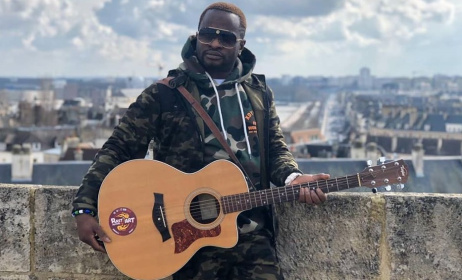Gumbe in Sierra Leone
One of the most influential and important music genres in Sierra Leone is gumbe. This genre, closely associated with the Krio, is also found in other West-African countries (especially Guinea- Bissau) and in the Caribbean.
 Sierra Leone's Refugee All Stars have songs based on the genre. Photo: Huck Magazine
Sierra Leone's Refugee All Stars have songs based on the genre. Photo: Huck Magazine Maracash. Photo: Sierra Leone Heritage
Maracash. Photo: Sierra Leone Heritage Improvised gumbe drum. Photo: Sierra Leone Heritage
Improvised gumbe drum. Photo: Sierra Leone Heritage
It has a rich history that is deeply intertwined with the history of the freed slaves who relocated during the 18th century [1]. This article focuses on the development of the genre in Sierra Leone, starting with its arrival in 1800 and concluding with modern day interpretations.
The Gumbe drum
The arrival of the gumbe drum in Sierra Leone is directly related to the history of the Maroons in Jamaica. These Maroons were former African slaves that had escaped into the mountains. There they preserved their culture for more than 200 years.
One of the most important cultural symbols preserved was the gumbe drum and its usage. It was played to enter a trance to establish a connection with the ancestors.[2] There is no information on the initial origins of the gumbe drum before Jamaica. After the Second Maroon War (1795-1796), a group of 550 Maroons was sent to Freetown, which was founded to accommodate freed slaves.[3] The Maroons arrived on the shores of the city with the gumbe drum.
Over time, the Krio, which are descendants of these freed slaves (including the Maroons), continued to use the gumbe drum in cultural events. One reason this happened was that the Krio were becoming highly influenced by Christianity and other British cultural practices. Thus the cultural symbolism of the gumbe drum grew as it united the different micro cultures within the Krio, thereby creating an opposing force to British influence. Today, the gumbe drum is still used in Freetown to enter into a trance and predict the future during cultural events.[4]
Gumbe as a genre
Gumbe as a genre is mainly percussive and vocal. The sound is produced using three key instruments: the gumbe drum, the maracash and the saw. The gumbe drum is a square drum big enough for the player to sit on. There are various way of playing the gumbe drum. One is to sit on the drum and play it with the heel of the foot, the second is to hold the drum between the knees and play it by hand. The maracash can be any kind of bottle and tin played rhythmically together. The saw is combined with another saw or knife to create a rasping sound.[5]
Milo jazz
What differentiates the Sierra Leonean version of gumbe from those played in other west African countries (or even in the Caribbean) is what is now called milo jazz. Olofemi Israel Cole, known as Dr. Oloh, popularised this version of gumbe. The empty cans of Milo, a brand of malt powder, are filled with stones in order to create a percussion instrument. When played together, they give off a unique sound which evolved the regular gumbe into milo jazz. Dr. Oloh and the Milo Jazz Band were hugely popular in the 1970s - 1990s.[6] After this introduction, milo jazz then became a genre of it’s own.
Modern day gumbe
Today, popular music is influenced by gumbe and milo jazz, especially in music by the New School artists. The Sierra Leonean New School refers to a group of musicians (not necessarily) from Freetown that have emerged on the scene in the past few years. These artists mainly have afropop, afrobeat, hip-hop and reggae in their repertoire and are celebrated for mixing these genres with traditional Sierra Leonean beats such as the gumbe and bubu. A few examples of New School artists that use these beats are Drizilik, Mijay, Block Jones and Yung Sal.
Artist that do not necessarily belong to the New School have also created hit songs with traditional beats. Tigaman, for example, is a soca/dancehall artist who merged Caribbean soca beats with Sierra Leonean gumbe beats. Another example is Arkman, who uses gumbe in his popular songs. Sierra Leone's Refugee All Stars have played music in the genre as well.
Conclusion
Gumbe, as both an instrument and a genre, is a remarkable symbol of Krio culture that has evolved over the past two centuries. Its origins remain unknown, but the route it has travelled in the past has allowed scholars to map the cultural significance attached to the instrument. It has served as a remembrance of the culture of relocated slaves. It has also served as a spiritual tool, allowing those who hear it within a specific context enter a trance. Nowadays, it serves as a component of Sierra Leonean pop music as it creates a local sound when mixed with other genres.
References
[1] Aranzadi, Isabela de. “A Drum’s Trans-Arlantic Journey from Africa to the Americas and Back after the end of Slavery: Annobonese and Fernandino musical cultures.” African Sociological Review 14 (1). Madrid, 2010. 21-22 [2] Bilby, Kenneth. “The Legacies of Slavery and Emancipation, Jamaica in the Atlantic World.” New Haven, Conneticut: Yale University, 2007. pp 108 [3] Rankin, F. Harrison, 1836. “The white man’s grave; a visit to Sierra Leone, in 1834. II.” London: Vol. R. Betlen, 1836. Vol. I,108 [4] Aranzadi, 2010, 23 [5] SierraLeoneHeritage.com [6] Roland Bankole Marke. “Dr. Oloh: A cornerstone of Sierra Leonean music.” The Patriotic Vanguard, 20 October 2007. (http://www.thepatrioticvanguard.com/dr-oloh-a-cornerstone-of-sierra-leonean-music)





















Commentaires
s'identifier or register to post comments